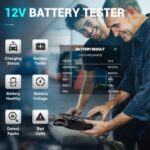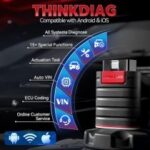For automotive technicians and car enthusiasts alike, effective driveability diagnostics hinges on having the right tools and knowledge. Among these tools, the OBD2 scan tool stands out as an indispensable asset. While factory scan tools offer comprehensive capabilities, generic OBD2 scan tools provide a cost-effective and powerful alternative, capable of addressing a significant portion of driveability issues. With the evolution of OBD2 standards, particularly the introduction of enhanced parameters, understanding data like Eq_rat Obd2 (Equivalence Ratio) has become crucial for accurate and efficient vehicle diagnostics.
This article delves into the world of OBD2 generic scan data, focusing on how to interpret key parameters and leverage them for diagnosing driveability problems. We’ll explore the significance of fuel trim, essential sensor readings, and, most importantly, how to utilize the EQ_RAT OBD2 parameter to gain deeper insights into your vehicle’s engine performance and air-fuel management. As OBD2 technology advances, mastering these parameters will undoubtedly sharpen your diagnostic skills and lead to more effective repairs.
Understanding Essential OBD2 Parameters for Driveability
Navigating driveability issues effectively starts with examining fundamental OBD2 parameters. These data points, accessible through your generic scan tool, offer a window into the engine control module’s (PCM) operation and adaptive strategies.
Fuel Trim: The Cornerstone of Fuel Delivery Diagnostics
Short-Term Fuel Trim (STFT) and Long-Term Fuel Trim (LTFT) are paramount parameters to monitor regardless of the driveability concern. Fuel trim acts as a real-time indicator of the PCM’s adjustments to fuel delivery, reflecting how the system is compensating for perceived lean or rich conditions. Expressed as percentages, ideal fuel trim values hover within ±5%.
Positive fuel trim percentages signal the PCM’s attempt to enrich the fuel mixture, counteracting a lean condition. Conversely, negative percentages indicate an effort to lean out the mixture due to a perceived richness. STFT fluctuates rapidly, while LTFT remains more stable, representing long-term adjustments. Deviations exceeding ±10% in either STFT or LTFT warrant further investigation.
To pinpoint the issue’s operating range, assess fuel trim at idle, 1500 RPM, and 2500 RPM. For instance, high LTFT (e.g., 25%) at idle that normalizes at higher RPMs points towards idle-specific lean conditions like vacuum leaks. If the lean or rich condition persists across all RPM ranges, suspect fuel supply issues such as a faulty fuel pump or restricted injectors.
Fuel trim is also invaluable for bank-specific diagnosis in V-engines or engines with bank-to-bank fuel control. Discrepancies between Bank 1 (B1) and Bank 2 (B2) LTFT readings, like a significant negative LTFT B1 and near-zero LTFT B2, isolate the problem to the cylinders of Bank 1.
Image: A screenshot of a scan tool interface displaying various OBD2 parameters, highlighting the data stream used for diagnosing driveability issues. Alt text: OBD2 scan tool data stream showing real-time parameters for engine diagnostics.
Key Parameters Influencing Fuel Trim and Overall Diagnostics
Beyond fuel trim, several other OBD2 parameters provide crucial context and can independently indicate problems.
- Fuel System Status 1 & 2: These should ideally display “Closed Loop” (CL). Open loop (OL) operation might indicate inaccurate fuel trim data, as the system isn’t using oxygen sensor feedback for fuel adjustments. Conditions like “OL-Drive” (open loop during power enrichment or deceleration) or “OL-Fault” (open loop due to system fault) offer more specific insights. “CL-Fault” might suggest a fuel control strategy deviation due to sensor issues.
- Engine Coolant Temperature (ECT): The engine should reach and maintain operating temperature, ideally above 190°F (88°C). Low ECT readings can trigger PCM enrichment, masking other fuel trim issues or indicating a thermostat problem.
- Intake Air Temperature (IAT): IAT should reflect ambient or underhood temperature, depending on sensor location. At Key On Engine Off (KOEO), IAT and ECT should be within 5°F (-15°C) of each other, indicating sensor plausibility.
- Mass Air Flow (MAF) Sensor: Present in many systems, the MAF sensor measures incoming air mass, a critical input for fuel calculations. Verify MAF sensor readings across RPM ranges, including Wide Open Throttle (WOT), against manufacturer specifications. Note the unit of measurement (grams per second (gm/S) or pounds per minute (lb/min)) to avoid misdiagnosis.
- Manifold Absolute Pressure (MAP) Sensor: MAP sensors measure manifold pressure, reflecting engine load. Readings are typically in inches of mercury (in./Hg). Distinguish MAP from manifold vacuum; MAP measures absolute pressure, while vacuum is the difference between barometric pressure and MAP. Some vehicles utilize MAF only, some MAP only, and some both.
- Oxygen Sensor Output Voltage (B1S1, B2S1, B1S2, etc.): Oxygen sensors monitor exhaust oxygen content, crucial for closed-loop fuel control and catalytic converter efficiency. Scan tools can assess basic sensor operation. Sensors should rapidly switch between below 0.2V (lean) and above 0.8V (rich). A “snap throttle” test can often verify this switching. Graphing scan tools enhance oxygen sensor analysis, allowing visualization of switching speed alongside STFT, LTFT, and RPM. However, remember OBD2 data is not real-time lab scope data; PCM processing and OBD2 data transmission speeds introduce delays. Data rates are also affected by the number of parameters requested, with single-parameter graphing yielding the fastest refresh rates. For detailed oxygen sensor analysis, a lab scope remains the definitive tool.
- Engine Speed (RPM) and Ignition Timing Advance: These parameters are useful for assessing idle control strategies, particularly with graphing scan tools.
- Vehicle Speed Sensor (VSS) and Throttle Position Sensor (TPS): Verify accuracy and utilize these as reference points for symptom duplication and data recording.
- Calculated Load, MIL Status, Fuel Pressure, and Auxiliary Input Status (PTO): These parameters offer supplementary diagnostic information when available.
Unveiling Advanced OBD2 Parameters: EQ_RAT and Beyond
Modern OBD2 systems, particularly CAN-equipped vehicles from 2004 onwards, and even some earlier models, offer a wealth of enhanced parameters that significantly boost diagnostic capabilities. Among these, EQ_RAT OBD2, or Equivalence Ratio, stands out as a powerful indicator of commanded air-fuel mixture.
Let’s examine some of these newer parameters, with a special focus on EQ_RAT:
- FUEL STAT 1 (Fuel System Status): Provides more granular fuel system status information than basic CL/OL, including reasons for open-loop operation like power enrichment or faults.
- ENG RUN TIME (Time Since Engine Start): Helps correlate problems with engine run cycles, useful for intermittent issues.
- DIST MIL ON (Distance Traveled While MIL Is Activated): Indicates how long a problem has persisted, potentially influencing diagnostic approach and customer communication.
- COMMAND EGR (EGR_PCT): Displays commanded Exhaust Gas Recirculation (EGR) valve position as a percentage, reflecting PCM commands, not actual flow.
- EGR ERROR (EGR_ERR): Quantifies EGR position errors as a percentage, calculated from the difference between actual and commanded EGR positions. High EGR Error values with commanded EGR off can indicate valve sticking or sensor malfunction.
- EVAP PURGE (EVAP_PCT): Shows commanded Evaporative Emission (EVAP) purge valve position as a percentage. Crucial for fuel trim diagnostics, as EVAP purge can influence fuel trim readings. Temporarily blocking the purge valve can isolate its effect on fuel trim issues.
- FUEL LEVEL (FUEL_PCT): Essential for system monitor readiness. Many monitors, like misfire and EVAP monitors, have fuel level preconditions (e.g., between 15% and 85%).
- WARM-UPS (WARM_UPS): Counts warm-up cycles since DTCs were cleared, useful for verifying conditions for monitors requiring multiple warm-up cycles. A warm-up is defined by a significant ECT rise and reaching a minimum temperature.
- BARO (BARO): Barometric pressure reading, valuable for verifying MAP and MAF sensor accuracy, especially considering altitude.
- CAT TMP B1S1/B2S1 (CATEMP11, 21, etc.): Catalyst temperature, either directly measured or inferred. Crucial for assessing catalyst performance and diagnosing overheating or premature failure.
- CTRL MOD (V) (VPWR): PCM voltage supply, often overlooked, but critical. Should closely match battery voltage. Low voltage can cause driveability problems. Note that ignition voltage supply, another critical PCM power source, often requires enhanced scan tools or direct measurement to check.
- ABSOLUT LOAD (LOAD_ABS): Normalized air mass per intake stroke, expressed as a percentage. Ranges differ for naturally aspirated (0-95%) and boosted engines (0-400%). Used for spark, EGR control, and diagnostic assessment of engine pumping efficiency.
EQ_RAT OBD2: Decoding Commanded Air-Fuel Ratio
OL EQ RATIO (EQ_RAT): This parameter, central to our discussion, represents the commanded equivalence ratio. Equivalence ratio is a normalized representation of the air-fuel ratio (AFR) relative to stoichiometry. Stoichiometry is the ideal AFR for complete combustion (approximately 14.7:1 for gasoline).
- EQ_RAT = 1.0: Indicates a stoichiometric commanded AFR.
- EQ_RAT < 1.0: Indicates a commanded lean AFR (more air than stoichiometric).
- EQ_RAT > 1.0: Indicates a commanded rich AFR (less air than stoichiometric).
For vehicles with conventional oxygen sensors, EQ_RAT OBD2 typically displays 1.0 in closed loop, reflecting the PCM’s target of stoichiometric combustion for optimal emissions and fuel efficiency. In open loop, it shows the PCM’s pre-programmed commanded EQ ratio, often used during cold starts, acceleration, or high load conditions.
Vehicles equipped with wide-range or linear oxygen sensors provide EQ_RAT OBD2 readings in both open and closed loop, offering a continuous view of the PCM’s commanded AFR targets.
To calculate the actual commanded AFR from EQ_RAT OBD2, use the following formula:
Commanded AFR = Stoichiometric AFR × EQ_RAT
For gasoline with a stoichiometric AFR of 14.64:1, an EQ_RAT of 0.95 translates to a commanded AFR of approximately 13.9:1 (14.64 × 0.95 = 13.9), indicating a slightly richer mixture than stoichiometric.
Understanding EQ_RAT OBD2 is critical for diagnosing fuel delivery issues, particularly in modern vehicles with complex fuel management strategies. By monitoring EQ_RAT in conjunction with fuel trim and oxygen sensor data, technicians can gain a comprehensive understanding of the PCM’s fuel control commands and identify deviations from expected values that point towards underlying problems. For example, consistently rich or lean commanded EQ_RAT values, even when fuel trim appears within acceptable limits, can indicate sensor calibration issues, PCM programming errors, or problems with the base fuel delivery system.
Interpreting CAN Bus Data and Scan Tool Limitations
Modern vehicles increasingly utilize Controller Area Network (CAN) bus communication for data exchange. Scan tools interacting with CAN systems might display symbols indicating ECU response status, as illustrated in Fig. 5 of the original article. Symbols like “>” (multiple ECU responses with differing values), “=” (multiple ECUs supporting the parameter with similar values), and “!” (no response received for a supported parameter) aid in diagnosing CAN bus communication issues.
It’s crucial to remember that OBD2 generic scan tools have limitations. Data refresh rates are not as fast as lab scopes, and requesting multiple parameters slows down the sample rate for each. Graphing individual parameters, especially oxygen sensor data, yields the best refresh rates. For high-resolution sensor analysis, lab scopes remain essential. Furthermore, the OBD2 generic specification is not always universally applied, necessitating reference to vehicle-specific service information for accurate specifications and variations.
Conclusion: Mastering OBD2 Data for Diagnostic Excellence
OBD2 generic scan data has evolved into a powerful diagnostic resource. Parameters like fuel trim, oxygen sensor readings, and the advanced EQ_RAT OBD2 parameter provide invaluable insights into engine performance and fuel management. By diligently monitoring and interpreting these parameters, automotive technicians can significantly enhance their diagnostic accuracy and efficiency.
Investing in a quality OBD2 generic scan tool with graphing and recording capabilities is a worthwhile investment that pays dividends in diagnostic proficiency. While mastering the expanding array of OBD2 parameters requires time and continuous learning, the diagnostic rewards are substantial. Always supplement scan tool data with vehicle-specific service information to account for manufacturer variations and ensure accurate diagnoses. Embrace the power of OBD2 data, including the crucial EQ_RAT OBD2 parameter, to elevate your automotive diagnostic skills and confidently tackle even the most challenging driveability issues.


